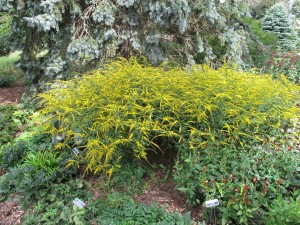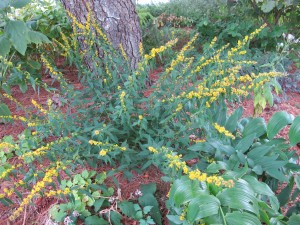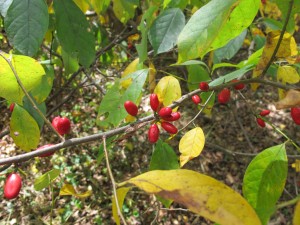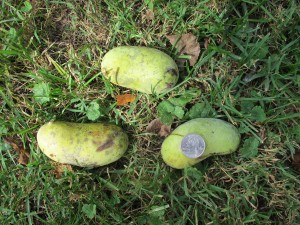Learning on the Road
I’m not much of a country music fan, but do love Willy Nelson’s “On the Road Again” – probably because I love to travel. Recently I’ve been on the road again, visiting friends and family in Pennsylvania and Ohio, traveling by car. Unlike Willy, it’s not the honkytonks or making music that interests me, it’s the public gardens, garden centers and private gardens. There is always something to learn.
While in Pennsylvania I visited Longwood Gardens in Kennett Square. These are at the home of the late Pierre S. Dupont which have been open to the public since the 1920’s. The gardens are largely formal, with huge expanses of lawn, fountains, shaped hedges and trees, ancient tulip poplars, displays of perennials, annuals, wonderful long shaded walkways, experimental plots and even a vegetable garden. A new addition is an 86-acre meadow, allowed to grow up in wild plants including many called weeds by gardeners. Right now dominant species include golden rods, fall asters and tall grasses.
Meanwhile, at the home of friends nearby, I spent time in a smaller version of the Longwood Meadow. Lisa and Chris Brinton bought a run-down farm about 30 years ago and have been working on it ever since. For the past decade that included bringing back to life a few acres of field that had been farmed for corn until the soil was depleted. When they bought the place the soil was so poor that even weeds had a hard time growing.
What struck me about their meadow was the number of bees, birds and butterflies. The field had been allowed to grow up in milkweed, goldenrod and native grasses. Trees that attract wildlife had been planted or allowed to colonize. It was a slow process as they didn’t bring in new topsoil, they just allowed leaves and grasses to decompose where they landed each fall and winter. Slowly the land came back to life. Mother Nature was allowed to reclaim the land.
Goldenrod gets a bad rap from most gardeners, but there are some varieties that are well mannered and beautiful at this time of year. I visited North Creek Nursery in Landenberg, Pennsylvania .This wholesale nursery grows hundreds of kinds of native plants, including half a dozen different kinds of goldenrod. Unlike the 5 to 6 foot giants that try to muscle their way into my gardens, they had some nice smaller varieties of goldenrod that I plan to grow.
Among their goldenrods there is an 18 to 36-inch tall shade-loving goldenrod, Solidago caesia, that I grew for some years before it was weeded out by a well-meaning helper. It’s hardy to Zone 4 and it thrives in dry shade. The small blossoms appear all the way up the stems. I also loved ‘Fireworks’ (a variety of Solidago rugosa). It stands about 3 feet tall, and prefers average to moist soils in full sun to half shade. Its blossoms are distributed along the stems, which arch out from this clump-forming perennial.
Of the various ornamental grasses I saw in the trial gardens at North Creek, my favorite was a little blue stem (Schizachyrium scoparium) called ‘Standing Ovation’. It is a North Creek introduction that is said to stand up well all year and at this time of year is a handsome reddish purple. It is hardy to Zone 3, meaning it will survive even our coldest winters.
Visiting friends in Athens, Ohio I liked the way my friends had terraced their gardens – without spending a fortune. Stone walls are great for creating terraces, but many of us cannot afford to make the investment. My friends used cement blocks that came with faux-stone fronts. The blocks stack nicely and lay flat, and hold back the soil to create level gardens. I have never worked with landscape blocks of this sort, but see that they are a good building material that is easier to work with than the irregular sizes and shapes of real stone.
Also in Ohio I saw spicebush (Lindera benzoin), a native understory shrub that has flavorful leaves and seeds. At the farmers market in Athens I bought some dried leaves for tea, and then saw it growing in the woods at my friends’ house. The bright red berries are very attractive right now, and I am told they can be used to flavor gin or as a substitute, dried and ground, for allspice. Birds love the seeds, robins in particular, and strip the berries in the fall when other foods become scarcer. Spicebush is a favorite food plant of two butterflies: the spicebush swallowtail and the promethea silkmoth. Spicebush is hardy to zone 4, and I definitely want to plant one.
In both Ohio and Pennsylvania I got to eat the fruit of the pawpaw tree (Asimina triloba). Pawpaw is a native fruit tree with fruit that is flavored somewhat like a cross between a banana and a mango. The flesh is mushy, and seeds are large. It is hardy to Zone 4, though not commonly grown in New England. I got a couple of small pawpaw trees early this summer, and one day maybe I’ll get fruit from my own trees.
Being a serious gardener means wherever I go I’ll have something interesting to see – and learn about.
Henry is the author of 4 gardening books. His Web site is www.Gardening-Guy.com. Contact him at henry.homeyer@comcast.net.






